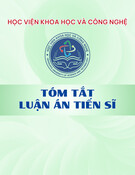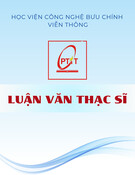
Trang 1
ABSTRACT
Nowadays, EEG signal, one of the most important field was
interested by science researchers, the main purpose of research is to
support application devlepments, diagnose and find out pathological
of human as stress, depression, epileptic, alzheimer, brain trauma…,
however, in the field of automatic control serving for human,
especially for disabilities people, has not been studied so much.
For long time ago, recording and processing the EEGs or ECGs
signal was the work of neurologists or cardiologists, nowadays, with
the development of modern signal processing and analysis tools such
as neural networks and AI systems, such signals can be processed to
meet the other needs, such as the control system support human
acitivites.The goal of this thesis is to build a control system, which
support some basic human activities through EEG signal. For
example, wheelchair equipement control for disabled people, meet
today’s pressing social needs.
In this thesis, author researched and analyzed three EEG signal
pre-processing methods as Fourier transform, Wavelet transform and
HHT transform, converting EEG signal to 5 basic EEG waves (Delta,
Theta, Alpha, Beta, Gamma), and then using data clustering technical
before put them into input layer of multilayer neural network. The
neural network was test from singlelayer to multilayer (3 layer).
Author combined the EEG signal processing system with HHT
pre-processing and image processing using multi neural network to
control the wheelchair model with accurate rate 92.4% for group 20
students, this shows the successful in the practical of the thesis.































